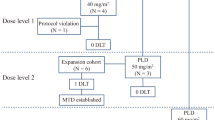Abstract
The dose of anthracyclines used during induction has been identified as a significant prognostic factor in acute leukemias. Liposomal encapsulation of anthracyclines has been proposed as a way of decreasing toxicity and probably increasing efficacy of these agents, therefore allowing the exploration of high-dose anthracycline therapy in acute leukemias. We conducted a phase I study of liposomal daunorubicin (Daunoxome® DNX) in patients with refractory or relapsed acute leukemias. Patients received three daily doses of DNX at 75, 100, 150 or 200 mg/m2 on each cycle, to a total dose of 225, 300, 450, and 600 mg/m2, respectively. At least three patients were included at each dose level before escalating to the next level, and patients could receive more than one course at the next dose level. Twenty-four patients were included and 23 are evaluable. Fifteen patients received one course, seven received two courses, and one received three courses of DNX. Seventeen patients had previously received anthracyclines. The dose-limiting toxicity was mucositis which occurred (grade 3–4) in 3 of 5 patients treated at 200 mg/m2, 2 of 9 treated at 150 mg/m2 and 1 of 6 at 100 mg/m2. Other non-hematologic toxicity was mild and infrequent. There was no change in post-LVEF among 9 patients with available data and no significant cardiac events were documented. Two patients had a complete response: one patient with chronic myeloid leukemia in refractory blast phase went back to chronic phase, and one patient with second relapse acute promyelocytic leukemia achieved a third complete remission. We conclude that the maximally tolerated dose of DNX in this schedule is 150 mg/m2 and has significant anti-leukemia activity.
Similar content being viewed by others
References
Cortes JE, Kantarjian HM: Acute lymphoblastic leukemia. A comprehensive review with emphasis on biology and therapy. Cancer 76: 2393–2417, 1995
Copelan EA, McGuire EA: The biology and treatment of acute lymphoblastic leukemia in adults. Blood 85: 1151–1168, 1995
Estey EH: Treatment of acute myelogenous leukemia and myelodysplastic syndromes. Seminars in Hematology 32: 132–151, 1995
Rowe JM, Liesveld JL: Treatment and prognostic factors in acute myeloid leukemia. Baillieres Clinical Hematology 9: 87–105, 1996
Head D, Kopecky KJ, Weick J et al.: Effect of aggressive daunomycin therapy on survival in acute promyelocytic leukemia. Blood 86: 1717–1728, 1995
Usui N, Dobashi N, Kobayashi T et al.: Role of daunorubicin in the induction therapy for adult acute myeloid leukemia. Journal of Clinical Oncology 16: 2086–2092, 1998
Todeschini G, Meneghini V, Pizzolo G et al.: Relationship between Daunorubicin dosage delivered during induction therapy and outcome in adult acute lymphoblastic leukemia. Leukemia 8: 376–381, 1994
Von Hoff DD, Rozencweig M, Layard M et al.: Daunomycininduced cardiotoxicity in children and adults. A review of 110 cases. American Journal of Medicine 62: 200–208, 1977
Kim S: Liposomes as carriers of cancer chemotherapy. Current status and future prospects. Drugs 46: 618–638, 1993
Rahman A, Fumagalli A, Goodman A et al.: Potential of liposomes to ameliorate anthracycline-induced cardiotoxicity. Seminars in Oncology 11: 45–55, 1984
Rarick MU, Gill PS, Wernz JC et al.: Dermatological toxicities associated with chemotherapy using liposomal encapsulated daunorubicin (DaunoXome). Proc Am Soc Clin Oncol 16: 248a (Abstract #878), 1997
Forssen EA, Coulter DM, Proffitt RT: Selective in vivo localization of daunorubicin small unilamellar vesicles in solid tumors. Cancer Research 52: 3255–3261, 1992
Gill PS, Espina BM, Muggia F et al.: Phase I/II clinical and pharmacokinetic evaluation of liposomal daunorubicin. Journal of Clinical Oncology 13: 996–1003, 1995
Guaglianone P, Chan K, DelaFlor-Weiss E et al.: Phase I and pharmacologic study of liposomal daunorubicin (DaunoXome). Investigational New Drugs 12: 103-110, 1994
Cohen P, Gill PS, Wernz J et al.: Absence of cardiac toxicity in patients who received 600 mg/m2 of liposomal encapsulated daunorubicin (DaunoXome). Proceedings ASCO 16: 217a (Abstract #761), 1997
Cortes J, Kantarjian H, Talpaz M et al.: Cyclophosphamide, ara-C, and Topotecan (CAT) for patients with chronic myelogenous leukemia in transformation. Blood 92: 627a (Abstract #2586), 1998
Beran M, Kantarjian H, O'Brien S et al.: Topotecan, a topoisomerase I inhibitor, is active in the treatment of myelodysplastic syndrome and chronic myelomonocytic leukemia. Blood 88: 2473–2479, 1996
Harvey J, Goodman A, McFadden M et al.: A phase I study of daunorubicin in advanced untreatable malignancies. Seminars in Oncology 11: 33–35, 1984
Woodcock TM, Allegra JC, Richman SP et al.: Pharmacology and phase I clinical studies of daunorubicin in patients with advanced malignancies. Seminars in Oncology 11: 28–32, 1984
Weil M, Glidewell OJ, Jacquillat C et al.: Daunorubicin in the therapy of acute granulocytic leukemia. Cancer Res 33: 921–928, 1973
Greene W, Huffman D, Wiernik PH et al.: High-dose daunorubicin therapy for acute nonlymphocytic leukemia: correlation of response and toxicity with pharmacokinetics and intracellular daunorubicin reductase activity. Cancer 30: 1419–1427, 1972
Gill PS, Wernz J, Scadden DT et al.: Randomized phase III trial of liposomal daunorubicin versus doxorubicin, bleomycin, and vincristine in AIDS-related Kaposi's sarcoma. Journal of Clinical Oncology 14: 2353–2364, 1996
Thierry AR, Vige D, Coughlin SS et al.: Modulation of doxorubicin resistance in multidrug-resistant cells by liposomes. FASEB Journal 7: 572–579, 1993
Thierry AR, Dritschilo A, Rahman A: Effect of liposomes on P-glycoprotein function in multidrug resistant cells. Biochemical & Biophysical Research Communications 187: 1098–1105, 1992
Mickisch GH, Rahman A, Pastan I et al.: Increased effectiveness of liposome-encapsulated doxorubicin in multidrugresistant-transgenic mice compared with free doxorubicin. Journal of the National Cancer Institute 84: 804-805, 1992
Oudard S, Thierry A, Jorgensen TJ et al.: Sensitization of multidrug-resistant colon cancer cells to doxorubicin encapsulated in liposomes. Cancer Chemotherapy & Pharmacology 28: 259–265, 1991
Author information
Authors and Affiliations
Rights and permissions
About this article
Cite this article
Cortes, J., O'Brien, S., Estey, E. et al. Phase I study of liposomal daunorubicin in patients with acute leukemia. Invest New Drugs 17, 81–87 (1999). https://doi.org/10.1023/A:1006216001681
Issue Date:
DOI: https://doi.org/10.1023/A:1006216001681



